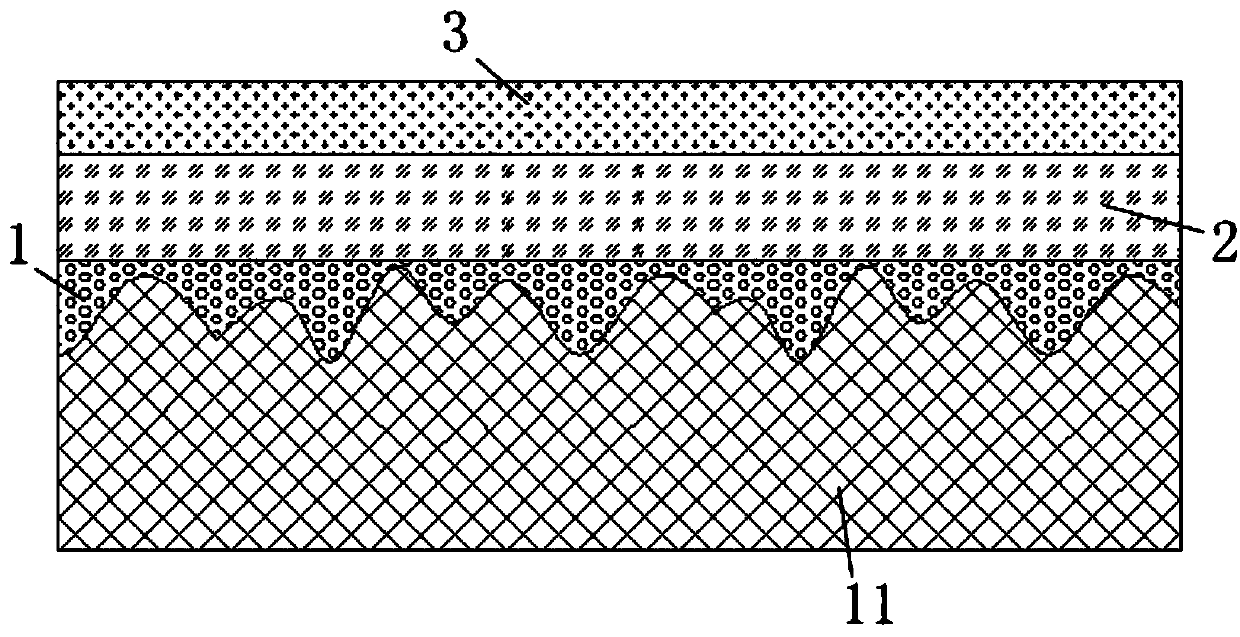High-strength die steel remanufacturing method
A die steel, high-strength technology, applied in the field of die steel, can solve the problems that die steel cannot adapt to high strength and excellent machining performance, achieve excellent machining performance, reduce energy consumption, and be easy to achieve
- Summary
- Abstract
- Description
- Claims
- Application Information
AI Technical Summary
Problems solved by technology
Method used
Image
Examples
Embodiment 1
[0037] First, a plurality of micro-nano grooves with different depths are formed on the surface of the high-strength mold steel 11 to be processed, and then metal nanoparticles with an average particle size of 7nm are consolidated in the multiple micro-nano grooves by PVD technology to form a transition The bottom layer 1, the material of the metal nanoparticles is mold steel with a Cr content that is 0.5% more than the high-strength die steel 11 to be processed, and then the iron-based alloy powder is fused on the transition bottom layer 1 by laser cladding technology to form a cladding middle layer 2. Finally, a silicon nitride layer is provided on the cladding intermediate layer 2 as the outermost protection layer 3 .
Embodiment 2
[0039] First, a plurality of micro-nano grooves with different depths are formed on the surface of the high-strength mold steel 11 to be processed, and then metal nanoparticles with an average particle size of 10nm are consolidated in the multiple micro-nano grooves by PVD technology to form a transition The bottom layer 1, the material of the metal nanoparticles is mold steel with a Cr content that is 0.9% more than the high-strength die steel 11 to be processed, and then the iron-based alloy powder containing ceria is fused on the transition bottom layer 1 by laser cladding technology A cladding intermediate layer 2 is formed, and finally a silicon carbide layer is provided on the cladding intermediate layer 2 as the outermost protective layer 3 .
Embodiment 3
[0041]First, a plurality of micro-nano grooves with different depths are formed on the surface of the high-strength mold steel 11 to be processed, and then metal nanoparticles with an average particle size of 15nm are consolidated in the multiple micro-nano grooves by PVD technology to form a transition The bottom layer 1, the material of the metal nanoparticles is mold steel with a Cr content that is 0.3% more than the high-strength die steel 11 to be processed, and then the iron-based alloy powder containing diyttrium trioxide is fused to the transition bottom layer 1 by laser cladding technology A cladding intermediate layer 2 is formed on the cladding intermediate layer 2, and finally a silicon nitride layer is provided on the cladding intermediate layer 2 as the outermost protective layer 3.
PUM
| Property | Measurement | Unit |
|---|---|---|
| particle size | aaaaa | aaaaa |
| diameter | aaaaa | aaaaa |
Abstract
Description
Claims
Application Information
 Login to View More
Login to View More - R&D
- Intellectual Property
- Life Sciences
- Materials
- Tech Scout
- Unparalleled Data Quality
- Higher Quality Content
- 60% Fewer Hallucinations
Browse by: Latest US Patents, China's latest patents, Technical Efficacy Thesaurus, Application Domain, Technology Topic, Popular Technical Reports.
© 2025 PatSnap. All rights reserved.Legal|Privacy policy|Modern Slavery Act Transparency Statement|Sitemap|About US| Contact US: help@patsnap.com

